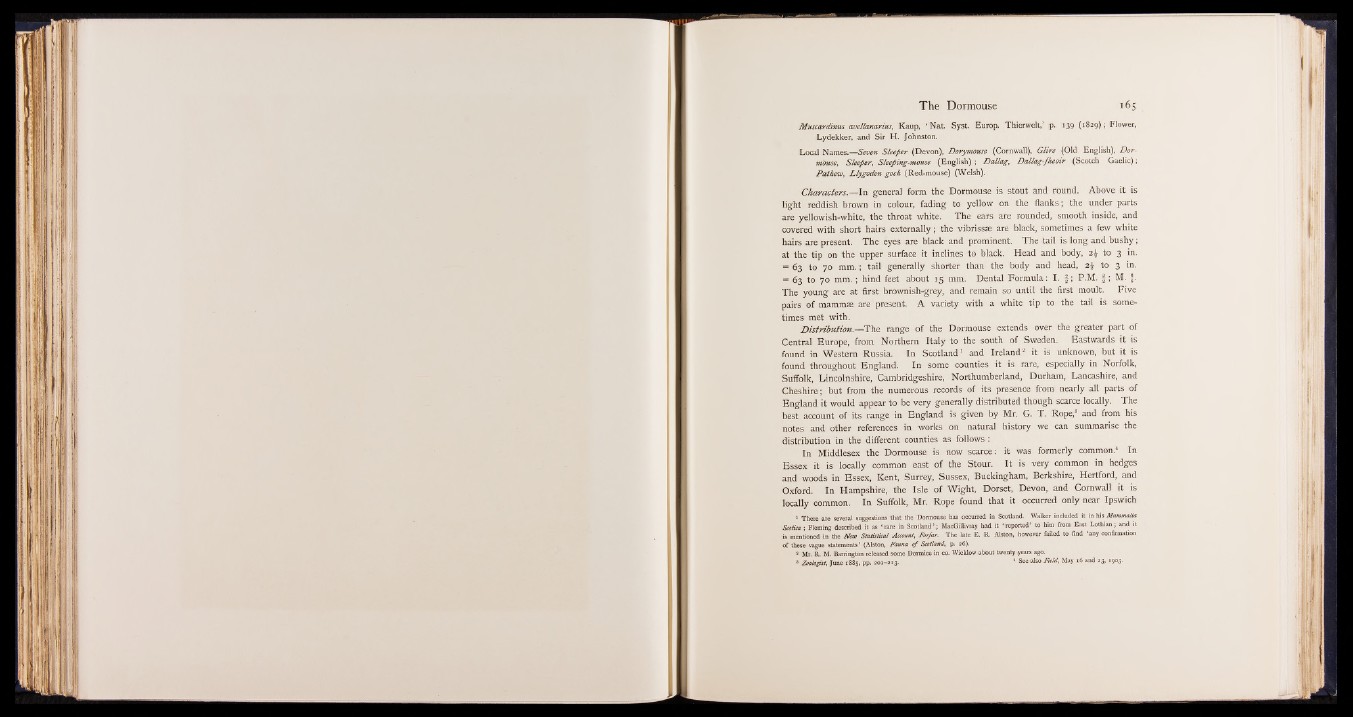
The Dormouse 165
Muscardinus avellanarius, Kaup, ‘Nat Syst. Europ. Thierwelt,’ p. 139 (1829); Flower,
Lydekker, and Sir H. Johnston.
Local Names.—Seven Sleeper (Devon), Dorymouse (Cornwall), G lire (Old English), Dormouse,
Sleeper, Sleeping-mouse (English); D allag, Dallag-fheoir (Scotch Gaelic);
Pathew, Llygoden goch (Red-mouse) (Welsh).
Characters.—I n general form the Dormouse is stout and round. Above it is
light reddish brown in colour, fading to yellow on the flanks; the under parts
are yellowish-white, the throat white. The ears are rounded, smooth inside, and
covered with short hairs externally; the vibrissse are black, sometimes a few white
hairs are present. The eyes are black and prominent. The tail is long and bushy;
at the tip on the upper surface it inclines to black. Head and body, 2^ to 3 in.
= 63 to 70 mm.; tail generally shorter than the body and head, 2% to 3 in.
= 63 to 70 mm.; hind feet about 15 mm. Dental Formula: I. f ; P.M. f ; M. f.
The young are at first brownish-grey, and remain so until the first moult. Five
pairs of mammae are present. A variety with a white tip to the tail is sometimes
met with.
D istribution.—The range of the Dormouse extends over the greater part of
Central Europe, from Northern Italy to the south of Sweden. Eastwards it is
found in Western Russia. In Scotland1 and Ireland2 it is unknown, but it is
found throughout England. In some counties it is rare, especially in Norfolk,
Suffolk, Lincolnshire, Cambridgeshire, Northumberland, Durham, Lancashire, and
Cheshire; but from the numerous records of its presence from nearly all parts of
England it would appear to be very generally distributed though scarce locally. The
best account of its range in England is given by Mr. G. T. Rope,8 and from his
notes and other references in works on natural history we can summarise the
distribution in the different counties as follows:
In Middlesex the Dormouse is now scarce: it was formerly common.4 In
Essex it is locally common east of the Stour. It is very common in hedges
and woods in Essex, Kent, Surrey, Sussex, Buckingham, Berkshire, Hertford, and
Oxford. In Hampshire, the Isle of Wight, Dorset, Devon, and Cornwall it is
locally common. In Suffolk, Mr. Rope found that it occurred only near Ipswich
1 There are several suggestions that the Dormouse has occurred in Scotland. Walker included it in his Mammalia
Scotica; Fleming described it as ‘ rare in Scotland’ ; MacGillivray had it ‘ reported’ to him from East Lothian; and it
is mentioned in the New Statistical Account, Forfar. The late E. R. Alston, however failed to find • any confirmation
of these vague statements’ (Alston, Fauna o f Scotland, p. 26).
* Mr. R. M. Barrington released some Dormice in co. Wicklow about twenty years ago.
* Zoologist, June 1885, pp. 201-213. 1 See also Field, May 16 and 23, 1903.